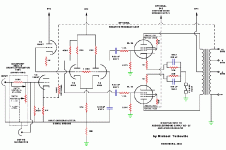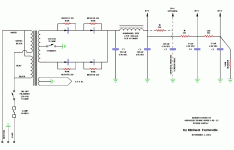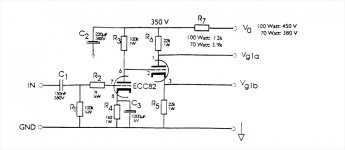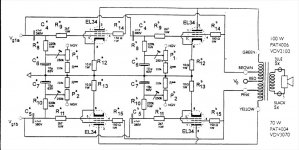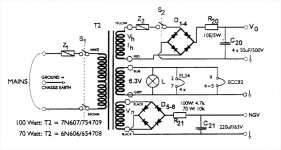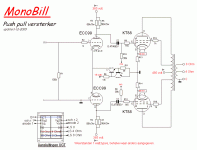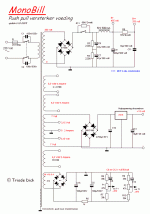robertc said:i heard that amp without nfb is more natural sound than with nfb. is that correct?
Don't believe everything you hear. Such sweeping statements are bound to be overturned by a single instance where they are proven not to be true. Last I looked, there were many such instances. The absense of NFB is by no means any guarantee of 'natura sound'.
Take a look at my 300B PP design, originally published in VTV some years back, available on my site now. You can sub a pair of triode connected KT88 quite easily in this design, all that is required is a minor adjustment to the output tube bias setting pot resistor strings.
Http://www.kta-hifi.net
This design has been built by a fair number of people worldwide and was also an inspiration to tubelab who built an "interpreted" version of the amplifier. (different tubes in the driver stage)
Triode connection will give you about 30W with KT88 in this design.
Http://www.kta-hifi.net
This design has been built by a fair number of people worldwide and was also an inspiration to tubelab who built an "interpreted" version of the amplifier. (different tubes in the driver stage)
Triode connection will give you about 30W with KT88 in this design.
I went to Kevins site and found the schematic here:
http://www.kta-hifi.net/projects/amp_page/300b_amp/30W Pushpull 300B Amplifier.pdf
As Kevin mentioned, I used this magazine article as the basis for my own 300B push pull amp. There is no feedback anywhere in the design, and it sounds great. It does not however sould like any of my non feedback SE amps. It has a much more dynamic, punchy sound, but lacks some of the detail associated with SE amps (may be the cheap transformers).
I have also built other push pull amps with no feedback, and a couple of unique amps with adjustable global feedback. One of these amps (KT88 P-P) was loaned to several people. This resulted in two things, The amp was sold, and one of the borrowers had me disconnect the feedback in his Cary KT88 amp.
I would attempt to listen to as many amps as possible to find out what you like. A lot depends on your speakers and how much damping they require. Feedback raises the damping factor, which often improves the speaker control in the bass region.
Kevins amp works great with 300B's. Some of this is due to their low plate resistance. Building this amp with KT88's may result in a slight loss of damping. This may or may not be an issue in your case.
All feedback is not evil. A little feedback can tighten up the sound of an amp. Too much will kill the sound. There were formulas in engineering school that reveal that if enough feedback is applied to an amp (any amp) the amp will take on the characteristics of the feedback network. This means that with enough feedback, all amps will sound the same. Have you been to a big box stereo store lately?
Whatever amp you build, allow some extra gain so that some feedback can be applied. If you don't like what it does to the sound, you can always remove it. Just don't get carried away. Most P-P amps may sound beter with a little feedback.
http://www.kta-hifi.net/projects/amp_page/300b_amp/30W Pushpull 300B Amplifier.pdf
As Kevin mentioned, I used this magazine article as the basis for my own 300B push pull amp. There is no feedback anywhere in the design, and it sounds great. It does not however sould like any of my non feedback SE amps. It has a much more dynamic, punchy sound, but lacks some of the detail associated with SE amps (may be the cheap transformers).
I have also built other push pull amps with no feedback, and a couple of unique amps with adjustable global feedback. One of these amps (KT88 P-P) was loaned to several people. This resulted in two things, The amp was sold, and one of the borrowers had me disconnect the feedback in his Cary KT88 amp.
I would attempt to listen to as many amps as possible to find out what you like. A lot depends on your speakers and how much damping they require. Feedback raises the damping factor, which often improves the speaker control in the bass region.
Kevins amp works great with 300B's. Some of this is due to their low plate resistance. Building this amp with KT88's may result in a slight loss of damping. This may or may not be an issue in your case.
All feedback is not evil. A little feedback can tighten up the sound of an amp. Too much will kill the sound. There were formulas in engineering school that reveal that if enough feedback is applied to an amp (any amp) the amp will take on the characteristics of the feedback network. This means that with enough feedback, all amps will sound the same. Have you been to a big box stereo store lately?
Whatever amp you build, allow some extra gain so that some feedback can be applied. If you don't like what it does to the sound, you can always remove it. Just don't get carried away. Most P-P amps may sound beter with a little feedback.
robertc said:anyone can show me where i can find a schematic or how to build a pushpull power amp without global nfb. by using el34 or kt88.
EL34s and KT88s are pentode types. These won't sound very good at all without gNFB. Bass will be too sloppy due to the high Zo of the final, and pentodes tend to add considerable, annoying "stridency" to the high end. Triodes such as the 300B, 45, or the vertical deflection amps (6CK4, etc.) might be useable without gNFB.
i heard that amp without nfb is more natural sound than with nfb. is that correct?
Don't believe everything you hear. This certainly is not correct, as NFB, either local, global, or both are highly effective methods for overcoming inevitable active device and xfmr nonlinearities. It's the misuse of NFB that's given it a bad rep in some audiophool circles. If you start off with a fundamentally good open loop design, gNFB can only improve it if done right.
No Nfb
"Don't believe every thing that you read
You've got a parking violation
and a maggot on your sleeve"
These guys are on the money! NFB has a bad rap by bum steers! NFB used correctly can reduce unwanted distortion. And some distortion is warm and good like drunken grandma keeping the stove warm in the kitchen. She made the best pancakes and I think she was fried 80% of the time! She was 100% when she slapped you with the stekspade. It is the same story with valve amps. Be wary of people who are too far into their own eccentricities to embrace what others are doing around them.
Shawn.
edit...fixed my poor spelling
"Don't believe every thing that you read
You've got a parking violation
and a maggot on your sleeve"
These guys are on the money! NFB has a bad rap by bum steers! NFB used correctly can reduce unwanted distortion. And some distortion is warm and good like drunken grandma keeping the stove warm in the kitchen. She made the best pancakes and I think she was fried 80% of the time! She was 100% when she slapped you with the stekspade. It is the same story with valve amps. Be wary of people who are too far into their own eccentricities to embrace what others are doing around them.
Shawn.
edit...fixed my poor spelling
Andrea Ciuffoli has a design here...
If you can afford this option you cannot be dissapointed. Interstage transformers give the detail of SE but with the benefits of PP. Placing CCS under each tube keeps things in class A, but allows your transformers to give of their absolute best, it also removes the need for bias re-adjustment.
I did this and detail resolution is scarily good.
Shoog
Hi Robert,
Here is a direct link to the article which is on my site:
http://kta-hifi.net/projects/amp_page/300b_amp/30WPushpull 300B Amplifier.pdf
You just needed to dig a little further.
Here is the page the link lives on. There is a little additional information here plus some pictures.
http://kta-hifi.net/projects/amp_page/300b_amp/300bpp.html
The full schematics are at the end of the article. Note that this was written for VTV originally and at a time when no one considered using 300B in PP amplifiers so you may find the opening paragraph a bit bombastic.. I know I do many years after the fact..
THD in this design using 300B's is under 1% all the way up to 25Wrms.
NFB is not required unless you need a lower output impedance. i.e. higher damping factor and the rated output power.
Here is a direct link to the article which is on my site:
http://kta-hifi.net/projects/amp_page/300b_amp/30WPushpull 300B Amplifier.pdf
You just needed to dig a little further.
Here is the page the link lives on. There is a little additional information here plus some pictures.
http://kta-hifi.net/projects/amp_page/300b_amp/300bpp.html
The full schematics are at the end of the article. Note that this was written for VTV originally and at a time when no one considered using 300B in PP amplifiers so you may find the opening paragraph a bit bombastic.. I know I do many years after the fact..
THD in this design using 300B's is under 1% all the way up to 25Wrms.
NFB is not required unless you need a lower output impedance. i.e. higher damping factor and the rated output power.
- Status
- This old topic is closed. If you want to reopen this topic, contact a moderator using the "Report Post" button.
- Home
- Amplifiers
- Tubes / Valves
- looking for pp amp schematic without nfb
